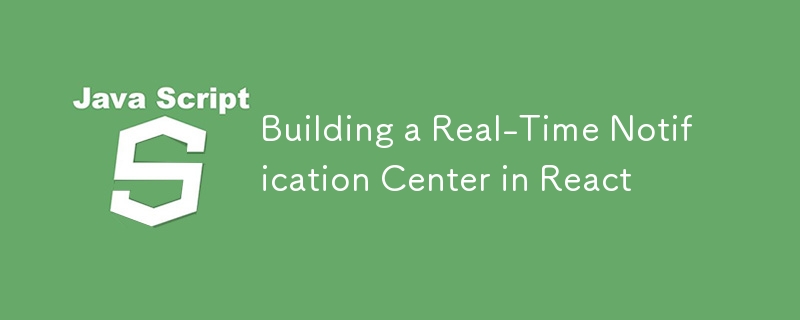ホームページ >ウェブフロントエンド >jsチュートリアル >React でリアルタイム通知センターを構築する
React でリアルタイム通知センターを構築する
- PHPzオリジナル
- 2024-08-24 11:14:02636ブラウズ

通知により、ユーザーは常に情報を入手し、関心を持ち続けることができます。カスタム React 通知センターを使用すると、ユーザー エクスペリエンスを完全に制御および調整できます。これは、リアルタイム更新のためのフロントエンド コンポーネントとバックエンド コンポーネントの両方をカバーする、ゼロから構築するための簡潔なガイドです。
1. React 通知センターの要件
- リアルタイム更新: 通知は更新せずに即座に表示されます。
- バックグラウンド通知: アプリがフォーカスされていないときでも、Service Worker を使用して通知を処理します。
- マルチチャネルのサポート: アプリ内通知、プッシュ通知、メール、SMS が含まれます。
- ユーザー設定: ユーザーが通知設定をカスタマイズできるようにします。
- スケーラビリティ: システムが大量の通知を処理できることを確認します。
- 信頼性: 通知は正確かつ迅速に配信される必要があります。
2. システムアーキテクチャの概要
フロントエンド
- React App: 通知を表示し、リアルタイムの更新を処理します。
- Service Worker: 通知 API を介してバックグラウンド通知を管理します。
- WebSocket/ポーリング: 通知フィードをリアルタイムで更新し続けます。
バックエンド
-
マイクロサービス:
- 通知サービス: 通知を生成および保存します。
- ディスパッチサービス: さまざまなチャネルに通知を送信します。
- ユーザー設定サービス: 通知のユーザー設定を管理します。
- メッセージ キュー: 通知の配布を効率的に処理します。
- データベース: ユーザー設定と通知ログを保存します。
- プッシュ サービス: プッシュ通知用に Firebase および APN と統合します。
3. バックエンドのアーキテクチャ
3.1.マイクロサービスの設計
| Microservice | Functionality |
|---|---|
| Notification Service | Generates and stores notifications |
| Dispatch Service | Sends notifications to different channels |
| User Preferences Service | Manages user settings and preferences |
3.2.データベース設計
- 通知テーブル: 通知メタデータを保存します。
- ユーザー設定テーブル: ユーザー設定を追跡します。
- ログ テーブル: 送信されたすべての通知の記録を保持します。
例: Node.js/Express の通知サービス
const express = require('express');
const app = express();
let notifications = [];
app.post('/notify', (req, res) => {
const notification = {
id: notifications.length + 1,
type: req.body.type,
message: req.body.message,
userId: req.body.userId,
status: 'unread',
timestamp: new Date()
};
notifications.push(notification);
res.status(200).send(notification);
});
app.listen(3000, () => {
console.log('Notification Service running on port 3000');
});
4. リアルタイム通信
4.1. WebSocket接続
- サーバー: 接続とブロードキャスト通知を処理します。
- クライアント: 更新をリッスンし、リアルタイムで UI を更新します。
例: Socket.IO を使用した WebSocket サーバー
const io = require('socket.io')(3001);
io.on('connection', (socket) => {
console.log('User connected:', socket.id);
socket.emit('notification', {
message: 'New notification!',
timestamp: new Date()
});
socket.on('disconnect', () => {
console.log('User disconnected:', socket.id);
});
});
React でのクライアント側の統合
import React, { useEffect, useState } from 'react';
import io from 'socket.io-client';
const socket = io('http://localhost:3001');
function NotificationCenter() {
const [notifications, setNotifications] = useState([]);
useEffect(() => {
socket.on('notification', (notification) => {
setNotifications(prev => [...prev, notification]);
});
}, []);
return (
<div>
<h2>Notification Center</h2>
{notifications.map((notif, index) => (
<div key={index}>{notif.message} - {notif.timestamp}</div>
))}
</div>
);
}
export default NotificationCenter;
4.2.フォールバックとしてのポーリング
- クライアント: 新しい通知がないかサーバーを定期的にチェックします。
例: React でのポーリングの実装
import React, { useEffect, useState } from 'react';
function NotificationCenter() {
const [notifications, setNotifications] = useState([]);
useEffect(() => {
const interval = setInterval(() => {
fetch('/api/notifications')
.then(response => response.json())
.then(data => setNotifications(data));
}, 5000); // Poll every 5 seconds
return () => clearInterval(interval);
}, []);
return (
<div>
<h2>Notification Center</h2>
{notifications.map((notif, index) => (
<div key={index}>{notif.message}</div>
))}
</div>
);
}
export default NotificationCenter;
5. 通知 API と Service Worker の統合
5.1.サービスワーカー
- 登録: バックグラウンド通知を処理します。
例: Service Worker の登録
if ('serviceWorker' in navigator) {
navigator.serviceWorker.register('/sw.js').then(registration => {
console.log('Service Worker registered:', registration.scope);
}).catch(error => {
console.error('Service Worker registration failed:', error);
});
}
5.2.通知API
- 権限の処理: 通知を表示するための権限を要求します。
- 通知のトリガー: アプリがアクティブでないときでも通知を表示します。
例: 通知の表示
if (Notification.permission === 'granted') {
new Notification('New message!', {
body: 'Click to view the message.',
icon: '/path/to/icon.png'
});
} else if (Notification.permission !== 'denied') {
Notification.requestPermission().then(permission => {
if (permission === 'granted') {
new Notification('New message!', {
body: 'Click to view the message.',
icon: '/path/to/icon.png'
});
}
});
}
6. Firebase と APN を使用したプッシュ通知
6.1. Firebase クラウド メッセージング (FCM)
- セットアップ: Firebase に登録し、トークンを取得します。
- 通知の送信: トークンを使用して通知を送信します。
例: Node.js の FCM を使用したプッシュ通知の送信
const admin = require('firebase-admin');
const serviceAccount = require('./path/to/serviceAccountKey.json');
admin.initializeApp({
credential: admin.credential.cert(serviceAccount)
});
const message = {
notification: {
title: 'New Notification',
body: 'You have a new notification!'
},
token: 'device-token'
};
admin.messaging().send(message)
.then(response => console.log('Message sent:', response))
.catch(error => console.error('Error sending message:', error));
6.2. Apple プッシュ通知サービス (APN)
- 統合: デバイス トークンを処理し、それを使用して APN 経由で通知を送信します。
7. React で通知センター UI を構築する
7.1.通知フィードの設計
- 通知リスト: 既読または削除としてマークするオプションを含むすべての通知を表示します。
- 通知バッジ: 未読通知数を表示します。
- トースト通知: 簡単な通知には、react-toastify などのライブラリを使用します。
例: 通知リストコンポーネント
import React from 'react';
function NotificationList({ notifications }) {
return (
<div>
{notifications.map(notification => (
<div key={notification.id}>{notification.message}</div>
))}
</div>
);
}
export default NotificationList;
例:react-toastify を使用したトースト通知
import { toast } from 'react-toastify';
import 'react-toastify/dist/ReactToastify.css';
toast.configure();
function notify() {
toast('New notification!', { position: toast.POSITION.BOTTOM_RIGHT });
}
notify();
7.2. Redux または Context API を使用した状態の管理
- グローバル ストア: Redux または Context API を使用して通知をグローバルに管理します。
- リアルタイム更新: WebSocket またはポーリング経由で新しい通知でストアを更新します。
例: Redux を使用した状態の管理
import { createSlice } from '@reduxjs/toolkit';
const notificationSlice = createSlice({
name: 'notifications',
initialState: [],
reducers: {
addNotification: (state, action) => {
state.push(action.payload);
},
markAsRead: (state, action) => {
const notification = state.find(n => n.id === action.payload);
if (notification) {
notification.read = true;
}
}
}
});
export const { addNotification, markAsRead } = notificationSlice.actions;
export default notificationSlice.reducer;
優秀な開発者としては、React で通知システムを最初から構築する必要がありますが、上司が早急に通知システムを必要としていて、休暇の計画がある場合 (または本当に休暇が必要な場合)、私の記事をチェックしてください。道具。すべてが簡素化され、すべての一般的な SDK で利用可能な新しい通知 API としてすぐに使用できるコンポーネントが提供されます。私たちがインフラを処理している間、あなたはくつろぐことができます。 ??
以上がReact でリアルタイム通知センターを構築するの詳細内容です。詳細については、PHP 中国語 Web サイトの他の関連記事を参照してください。

